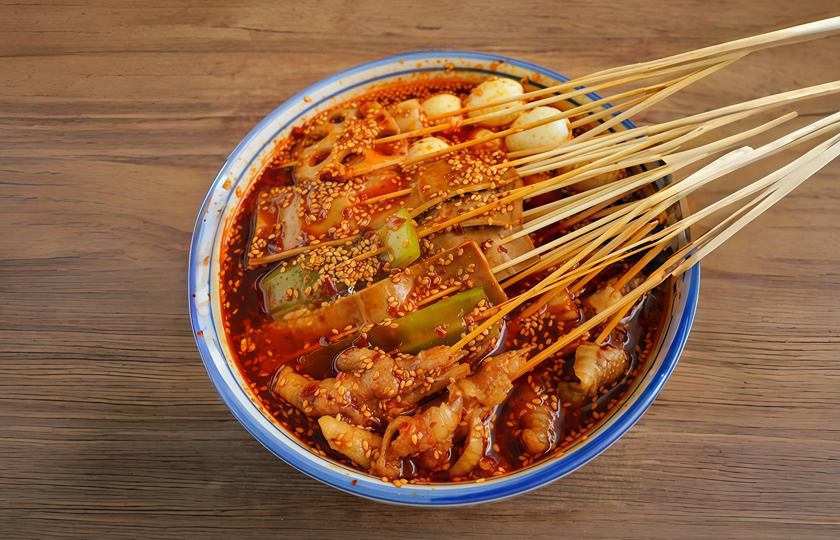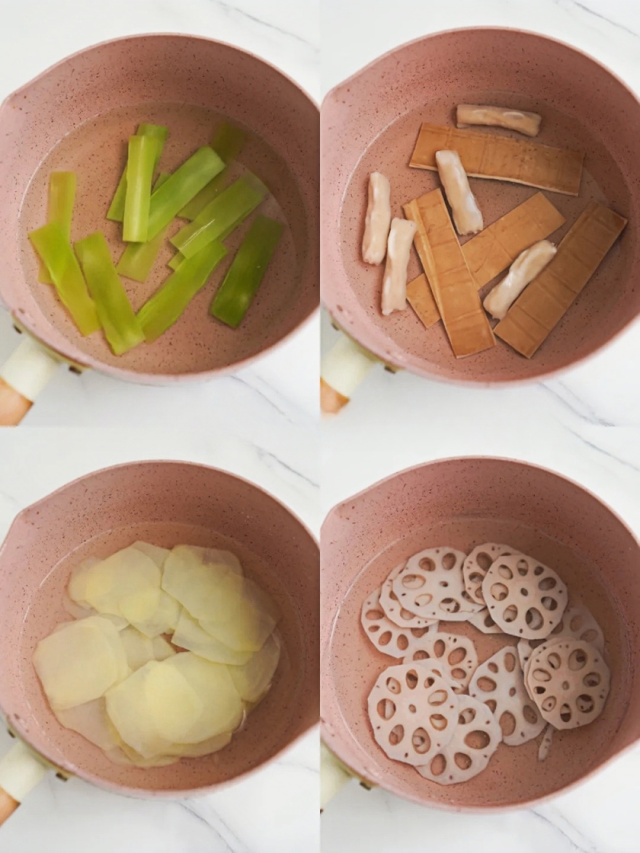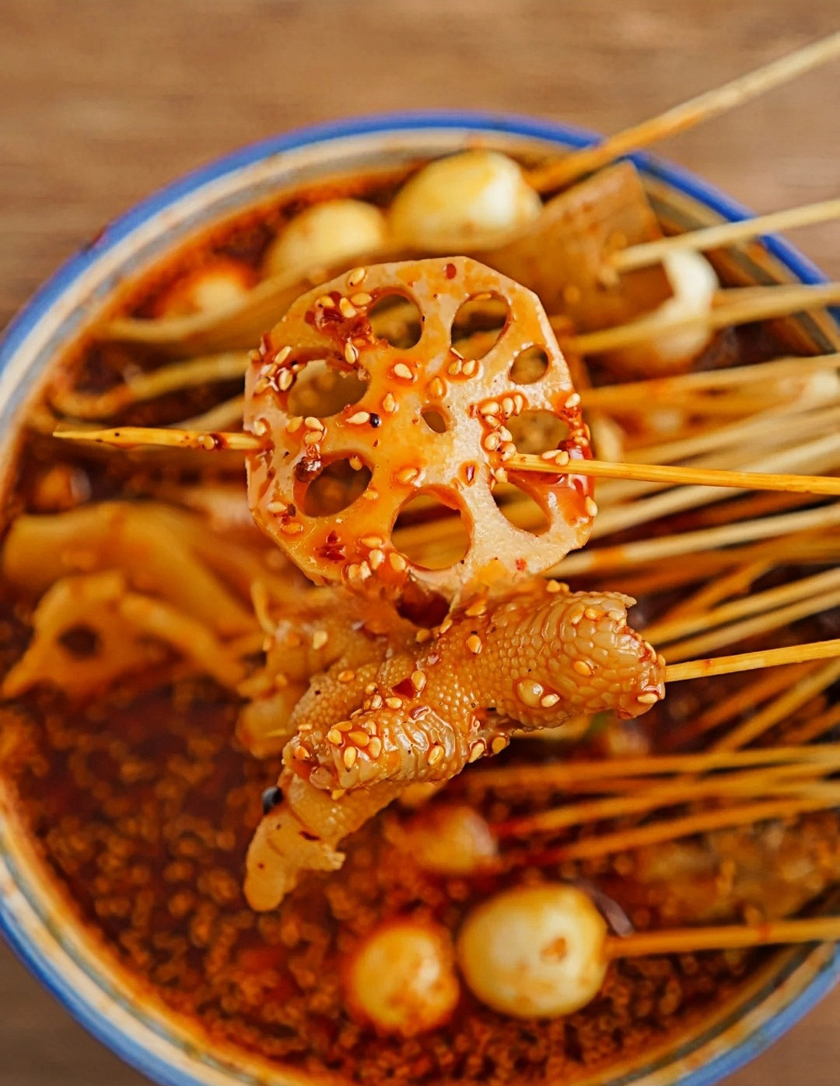Bobo Chicken: Sichuan's Skewered Sensation

Ever wondered what those colorful skewers swimming in red oil at Chinese restaurants are? Meet Bobo Chicken(Bo Bo Ji) - a legendary street food from Chengdu, Sichuan that's taking the world by storm!
What is bo bo ji?
Bobo Chicken is a famous street snack in Chengdu, Sichuan Province. It originated in the Qing Dynasty. Spicy seasonings are placed in earthenware pots. Various ingredients are cooked, threaded on skewers, and soaked to absorb the flavor.
It is also a cold appetizer. You can think of it as a customizable Chinese "pick and mix" dish where you can choose your favorite ingredients!
Its characteristics are spicy, fragrant, moderately sweet and salty, convenient to eat, and the amount can be controlled according to your preference.
Why is it called "Bobo Chicken"?
"Bobo" refers to the bowl used to hold the ingredients.
Originally, chicken was the main ingredient.
Over time, it evolved to include a variety of ingredients, all of which can be "skewered" and added to the dish.
What are the common ingredients for Bobo Chicken?
Main ingredients:
Chicken (about 500g, you can use chicken legs, wings, or feet based on your preference).
Beef tripe, and pork throat.
Vegetables like potatoes, lotus root slices, wood ear mushrooms, kelp knots, broccoli, etc.
Various types of meatballs, such as fish balls, shrimp balls, etc.
Gluten, dried tofu, and tripe.
Quail eggs, luncheon meat... Feel free to add whatever you like, and mix and match to your heart’s content!
Basically, use whatever you have in your fridge!
Bamboo skewers for threading the ingredients.
A seasoning packet
You can buy ready-made Bobo Chicken seasoning packs online, which typically come in flavors like spicy red oil or Sichuan pepper.
Today, I'm making a simple version with flexible ingredients.

INGREDIENTS
Main Ingredients
-
·1 potato
-
·1 lotus root
-
·1 asparagus lettuce
-
·1 box of quail eggs
-
·3 pieces of tofu skin
-
·5 shrimp dumplings
-
·3 chicken feet
-
·3 chicken wing tips
Additional Ingredients
-
·Bamboo skewers
Seasonings
-
·Bobo Chicken seasoning packet
COOKING STEP
Step 1
Slice the asparagus lettuce, potato, lotus root, and tofu skin, then cook them in boiling water until just tender.

Step 2
Blanch the chicken feet and chicken wing tips, then cook them fully. Afterward, soak them in cold water to make the meat firmer and more flavorful.

Step 3
Boil the quail eggs until cooked, then peel the shells.

Step 4
Prepare the broth:
Open the Bobo Chicken seasoning packet, which usually contains red oil, seasoning mix, and sesame seeds.
Pour the seasoning into a large bowl. According to the instructions on the packet, add the appropriate amount of purified water (usually about 1 part seasoning to 3 or 4 parts water). I used 500ml of water here.
Then stir well until the seasoning is fully dissolved, creating the broth for the Bobo Chicken.

Step 5
Skewer the cooked ingredients onto bamboo sticks.

Step 6
Soak the skewered ingredients:
Place the skewers into the prepared broth, ensuring all ingredients are fully submerged. Let them soak for about 30 minutes to allow the flavors to fully infuse.

Step 7
After soaking, your delicious Bobo Chicken is ready to enjoy!

Ultimate Bobo Chicken Pairing Guide
Protein & Veggie Combo
Must-Try Proteins:
• Chicken: Tender and juicy
• Beef Tripe: Crispy and tender
• Duck Throat: Perfectly chewy
• Duck Tongue: Unique texture
Veggie Recommendations:
• Lotus Root: Fresh and crunchy
• Seaweed: Collagen-rich
• Black Fungus: Nutrient-packed
• Tofu Skin: Soaks up all the flavors
The Perfect Combo Formula
For a balanced meal, grab:
• 2-3 skewers of protein
• 3-4 skewers of veggies
• 1-2 skewers of tofu products
• 1 skewer of egg products
Trust us, this ratio hits different!
Eating Order Pro-Tip
Start light (lotus root, bean sprouts)
Move to chewy stuff (tripe, duck throat)
Finish with the main proteins (chicken)
Perfect Pairings
• White Rice: Tames the heat, hits the spot
• Noodles: Rich and satisfying
• Ice-Cold Beer: Refreshing kick
• Mung Bean Soup: Cooling effect
• Sour Plum Drink: Appetite booster

How should leftover Bobo Chicken be stored?
Separate the Bobo Chicken ingredients and the soup. Put the ingredients in a sealed container, and also put the soup in a sealed container. Put them together in the refrigerator's cold storage compartment and eat them within 1-2 days.
When you want to eat it again, put the ingredients back into the soup and soak them for a while so that the ingredients can reabsorb the flavor of the soup.
FAQs:
You can either reduce the amount of ingredients or increase the seasoning mix. Additionally, you can let the food marinate in the seasoning for a longer time.
For example, if you usually soak it for 30 minutes, extend it to 1-2 hours to allow the flavors to penetrate better.
To cut down on the oiliness, use a spoon to skim off the excess oil. You can also balance the greasy texture by adding lemon juice or vinegar to the sauce.
For every 500ml of seasoning, add about 1-2 tablespoons of lemon juice or vinegar to brighten the flavor.
For example, vegetables like broccoli and wood ear mushrooms cook quickly, usually needing only 1-2 minutes of blanching.
Ingredients like lotus root slices or potatoes can be boiled for 2-3 minutes.
For meat, chicken generally takes 15-20 minutes to cook through.
After cooking the meat, discard the water, change to fresh water, and then cook the vegetables.
This ensures the vegetables stay fresh and crisp without absorbing the meat’s foam or any off-flavors.
This helps lower the temperature quickly, slowing down the oxidation process and preventing color changes.
Try cutting the ingredients into evenly sized, skewer-friendly pieces. Choose slightly thicker skewers for better stability.
Also, when skewering, insert the skewer through the center of the food to ensure it stays securely in place.
For softer ingredients like tofu, try skewering 2-3 pieces at a time to improve stability.

















